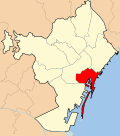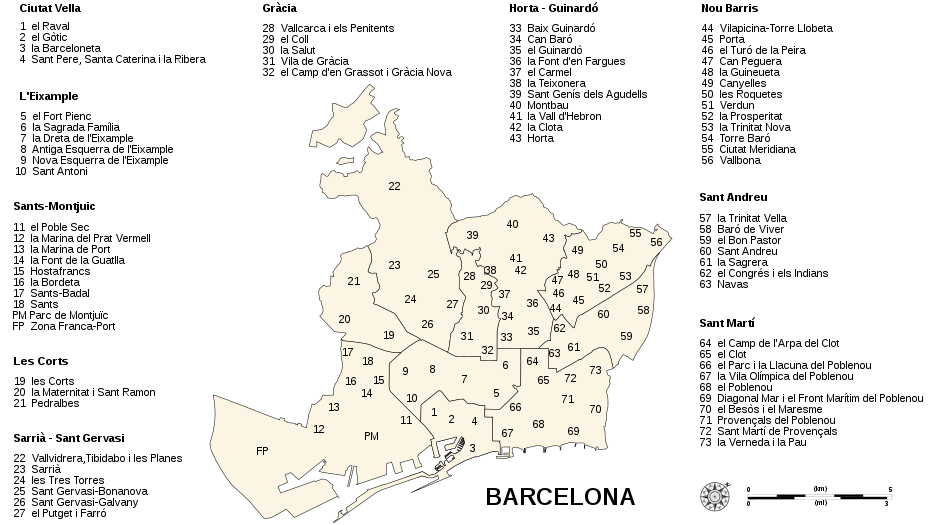
Barcelona , Catalonia, Spain is divided into 10 districts. These are administered by a councillor designated by the main city council, and each of them have some powers relating to issues such as urbanism or infrastructure in their area. The current division of the city into different districts was approved in 1984. [1] In 2009 Barcelona started using a new division of 73 neighbourhoods (the 10 districts are still in use), a division that was done for a better service from the City Council. [1]
Contents
Some of these districts have a previous history as independent municipalities which were integrated into the city of Barcelona during the late 19th century and the first half of the 20th century, such as Sarrià, Les Corts, Sant Andreu de Palomar, Gràcia or Sant Martí de Provençals. However, other municipalities which are contiguous to Barcelona (such as L'Hospitalet de Llobregat, Badalona, Sant Adrià de Besòs or Montcada i Reixac) have remained separate towns to this day, and are part of the much larger metropolitan area of Barcelona.
| Nº. | District | Location | Size km2 [2] | Population [3] | Density inhabitants/km2 | Neighbourhoods [4] | ||||
|---|---|---|---|---|---|---|---|---|---|---|
| Nº | Name | Population | Size (ha) | |||||||
| 1 | Old City |  | 4.11 | 109,672 | 26,684.2 | 1 | El Raval | 48,688 | 110 | |
| 2 | El Gòtic | 22,850 | 81.6 | |||||||
| 3 | La Barceloneta | 15,125 | 109.5 | |||||||
| 4 | Sant Pere, Santa Caterina i la Ribera | 23,009 | 111 | |||||||
| 2 | Eixample |  | 7.46 | 269,349 | 36,105.8 | 5 | Fort Pienc | 33,445 | 92.9 | |
| 6 | Sagrada Família | 52,164 | 104.2 | |||||||
| 7 | Dreta de l'Eixample | 44,088 | 212 | |||||||
| 8 | L'Antiga Esquerra de l'Eixample | 43,046 | 122.8 | |||||||
| 9 | La Nova Esquerra de l'Eixample | 57,906 | 134.1 | |||||||
| 10 | Sant Antoni | 38,700 | 80.4 | |||||||
| 3 | Sants-Montjuïc |  | 22.68 | 187,026 | 8,246.3 | 11 | Poble-sec | 40,204 | 458.5 | |
| 12 | la Marina del Prat Vermell | 1,356 | 1,403.4 | |||||||
| 13 | la Marina de Port | 31,092 | 126.9 | |||||||
| 14 | la Font de la Guatlla | 10,239 | 29.7 | |||||||
| 15 | Hostafrancs | 16,102 | 41 | |||||||
| 16 | la Bordeta | 19,451 | 57.2 | |||||||
| 17 | Sants-Badal | 24,903 | 41.5 | |||||||
| 18 | Sants | 43,679 | 109.5 | |||||||
| 4 | Les Corts |  | 6.02 | 81,576 | 13,550.8 | 19 | les Corts | 45,943 | 141 | |
| 20 | la Maternitat i Sant Ramon | 23,825 | 191.5 | |||||||
| 21 | Pedralbes | 11,808 | 268.5 | |||||||
| 5 | Sarrià-Sant Gervasi |  | 19.91 | 149,201 | 7,493.8 | 22 | Vallvidrera, el Tibidabo i les Planes | 4,760 | 1,132.9 | |
| 23 | Sarrià | 24,769 | 304.7 | |||||||
| 24 | les Tres Torres | 16,356 | 78.8 | |||||||
| 25 | Sant Gervasi - la Bonanova | 25,984 | 223.4 | |||||||
| 26 | Sant Gervasi - Galvany | 47,346 | 166.9 | |||||||
| 27 | el Putxet i el Farró | 29,986 | 84.8 | |||||||
| 6 | Gràcia |  | 4.19 | 123,276 | 29,421.5 | 28 | Vallcarca i els Penitents | 16,325 | 125.1 | |
| 29 | el Coll | 7,688 | 35.3 | |||||||
| 30 | la Salut | 13,455 | 64.8 | |||||||
| 31 | Vila de Gràcia | 50,456 | 132.1 | |||||||
| 32 | Camp d'en Grassot i Gràcia Nova | 35,352 | 65.1 | |||||||
| 7 | Horta-Guinardó |  | 11.96 | 173,944 | 14,543.8 | 33 | el Baix Guinardó | 25,842 | 56.2 | |
| 34 | Can Baró | 9,320 | 38.4 | |||||||
| 35 | el Guinardó | 37,325 | 130.9 | |||||||
| 36 | la Font d'en Fargues | 9,505 | 65.7 | |||||||
| 37 | el Carmel | 32,724 | 94 | |||||||
| 38 | la Teixonera | 12,044 | 33.8 | |||||||
| 39 | Sant Genís dels Agudells | 7,385 | 168.1 | |||||||
| 40 | Montbau | 5,114 | 205.5 | |||||||
| 41 | la Vall d'Hebron | 5,932 | 74.5 | |||||||
| 42 | la Clota | 698 | 17.8 | |||||||
| 43 | Horta | 28,055 | 307 | |||||||
| 8 | Nou Barris |  | 8.05 | 173,552 | 21,559.3 | 44 | Vilapicina i la Torre Llobeta | 25,875 | 56.4 | |
| 45 | Porta | 27,796 | 83.7 | |||||||
| 46 | el Turó de la Peira | 16,186 | 35.4 | |||||||
| 47 | Can Peguera | 2,215 | 11.9 | |||||||
| 48 | la Guineueta | 15,267 | 61.2 | |||||||
| 49 | Canyelles | 6,813 | 79 | |||||||
| 50 | les Roquetes | 16,563 | 64.3 | |||||||
| 51 | Verdum | 12,865 | 23.7 | |||||||
| 52 | la Prosperitat | 26,868 | 59.1 | |||||||
| 53 | la Trinitat Nova | 7,628 | 57.7 | |||||||
| 54 | Torre Baró | 2,923 | 174.2 | |||||||
| 55 | Ciutat Meridiana | 11,152 | 37.7 | |||||||
| 56 | Vallbona | 1,401 | 60.8 | |||||||
| 9 | Sant Andreu |  | 6.59 | 151,537 | 22,995 | 57 | la Trinitat Vella | 10,513 | 80.8 | |
| 58 | Baró de Viver | 2,653 | 23 | |||||||
| 59 | Bon Pastor | 13,730 | 186.5 | |||||||
| 60 | Sant Andreu de Palomar | 58,225 | 186.7 | |||||||
| 61 | la Sagrera | 29,568 | 98.6 | |||||||
| 62 | el Congrés i els Indians | 14,549 | 40.9 | |||||||
| 63 | Navas | 22,299 | 42.4 | |||||||
| 10 | Sant Martí |  | 10.39 | 241,181 | 23,212.8 | 64 | el Camp de l'Arpa del Clot | 38,838 | 74.1 | |
| 65 | el Clot | 26,759 | 69.7 | |||||||
| 66 | el Parc i la Llacuna del Poblenou | 15,914 | 112.2 | |||||||
| 67 | la Vila Olímpica del Poblenou | 9,395 | 92.5 | |||||||
| 68 | Poblenou | 34,411 | 156.7 | |||||||
| 69 | Diagonal Mar i el Front Marítim del Poblenou | 13,536 | 120.3 | |||||||
| 70 | el Besòs i el Maresme | 26,116 | 118.5 | |||||||
| 71 | Provençals del Poblenou | 21,185 | 108.6 | |||||||
| 72 | Sant Martí de Provençals | 26,229 | 73.4 | |||||||
| 73 | la Verneda i la Pau | 28,798 | 112.7 | |||||||
| Nota *: Montjuïc and Zona Franca are not neighbourhoods but are in the district of Sants-Montjuïc. | ||||||||||


